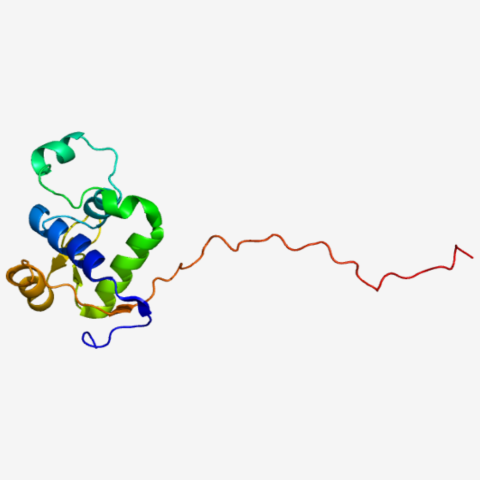
Illustration of the Werner Syndrome helicase (WRN). Image credit: Wikipedia Commons.
Rapid and acute inactivation of the Werner Syndrome helicase (WRN), a protein upon which cancer cells that exhibit microsatellite instability (MSI) often rely for survival, can be an effective anti-tumor strategy, according to CCR researchers. They believe that knowledge gained from their laboratory finding may be useful in guiding the development of drugs that could act as WRN inhibitors in people.
The research, led by Andre Nussenzweig, Ph.D., Chief of the Laboratory of Genome Integrity, was reported in print on October 1, 2023, in Genes & Development.
About 15% of colorectal cancers and about 10% to 20% of stomach and endometrial cancers exhibit MSI, a condition caused by the genetic inactivation of a cellular DNA repair pathway responsible for fixing mutated tumor DNA. Patients with these tumors do not typically benefit from conventional chemotherapy, and immunotherapy has been ineffective in roughly half of patients with MSI tumors.
“Recent research has shown that many MSI cancers are specifically reliant on WRN for survival, and this dependency on WRN seems to be almost universal among MSI colorectal cancers, making it a hugely promising drug target,” says Nussenzweig. “In addition, since non-MSI cells were not adversely affected when we induced a loss of WRN, inactivation of WRN by a drug might result in relatively few side effects.”
In their study, the scientists modeled acute WRN inhibition in cultured cells in the lab using CRISPR gene editing and a protein degradation strategy. The degradation strategy involved adding a piece of DNA to the WRN gene; the newly stitched-together gene then produced a modified WRN protein that was still functional as it promoted the survival of MSI cancer cells. However, this modified protein could bind a small molecule called dTAG that marks the protein for rapid degradation. In this way, explains Nussenzweig, “an MSI cancer cell previously containing WRN can be rapidly turned into one with no detectable WRN protein, allowing us to analyze the consequences of WRN loss with remarkable clarity.”
The research effort builds on prior studies into MSI cells by Nussenzweig’s lab and others but incorporates a quicker and more precise technique that gives a highly realistic picture of what a potential WRN inhibitor could do in people. Indeed, the investigators were able to detect the immediate consequences of WRN loss, such as accrual of replication-associated DNA breakage, inadequate DNA repair and progression into late events, such as cell death and cell cycle arrest.
The researchers also looked into whether another drug can be used in combination with WRN inhibition in situations where complete WRN degradation/inhibition could not be achieved. They found that the addition of a low dose of an FDA-approved drug known as an ATR inhibitor, which limits the cell’s response to DNA damage, significantly increased the efficacy of tumor cell killing, even when WRN was only partially inactivated. They believe that dual use of a WRN-targeted drug and an ATR inhibitor might be a useful strategy for treating MSI cancers.
“Although many cancers exhibit MSI, most do not. Therefore, the utility of clinical WRN inhibitors, though significant, would still be limited,” says Dali Zong, Ph.D., a staff scientist in Nussenzweig’s lab and first author of this finding. “However, if we can find ways to make microsatellite-stable cancers respond to WRN inhibition, perhaps by converting them to MSI cells, we can potentially broaden the utility of these drugs. This won’t be easy, but it is among one of our long-term goals.”